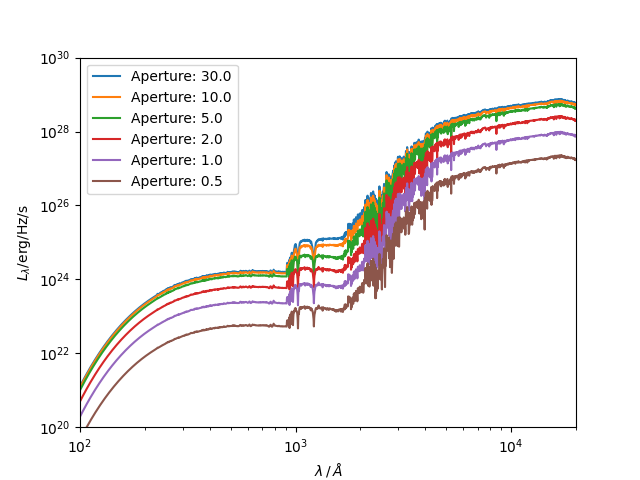Note
Go to the end to download the full example code.
Aperture Mask Example¶
Show how to implement fixed spherical apertures when getting the emission from galaxy objects.

Galaxy centre from file: gal.centre [ 862.6617 15728.44 7978.029 ] kpc
Stars centre adopted from parent galaxy: gal.stars.centre [ 0.8626617 15.728441 7.9780293] Mpc
Stars centre of mass: gal.stars.centre = [ 0.8626617 15.728441 7.9780293] Mpc
Galaxy centre unchanged: gal.centre = [ 862.6617 15728.44 7978.029 ] kpc
import matplotlib.pyplot as plt
import numpy as np
from unyt import kpc
from synthesizer.emission_models import IncidentEmission
from synthesizer.grid import Grid
from synthesizer.load_data.load_camels import load_CAMELS_IllustrisTNG
grid_dir = "../../tests/test_grid"
grid_name = "test_grid"
grid = Grid(grid_name, grid_dir=grid_dir)
gals = load_CAMELS_IllustrisTNG(
"../../tests/data/",
snap_name="camels_snap.hdf5",
group_name="camels_subhalo.hdf5",
group_dir="../../tests/data/",
)
# Define an emission model
model = IncidentEmission(grid)
# Select a single galaxy
gal = gals[1]
# Test calculating the centre manually
print("Galaxy centre from file: gal.centre", gal.centre)
print(
"Stars centre adopted from parent galaxy: gal.stars.centre",
gal.stars.centre,
)
gal.stars.calculate_centre_of_mass()
print("Stars centre of mass: gal.stars.centre = ", gal.stars.centre)
print("Galaxy centre unchanged: gal.centre = ", gal.centre)
fig, ax = plt.subplots(1, 1)
for aperture_radius in np.array([30, 10, 5, 2, 1, 0.5]) * kpc:
spec = gal.stars.get_spectra(model, aperture=aperture_radius)
ax.loglog(spec.lam, spec.lnu, label=f"Aperture: {aperture_radius.value}")
ax.set_ylim(1e20, 1e30)
ax.set_xlim(1e2, 2e4)
ax.legend()
ax.set_xlabel("$\\lambda \\,/\\, \\AA$")
ax.set_ylabel("$L_{\\lambda} / \\mathrm{erg / Hz / s}$")
plt.show()
Total running time of the script: (0 minutes 0.825 seconds)